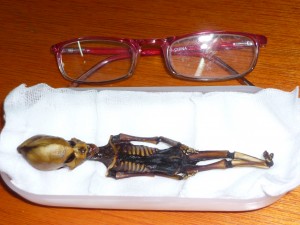May 07 2013
Atacama Specimen
One persistent theme that skeptical investigators encounter is the fact that true-believers of various stripes often whine about the fact that they are not taken seriously by scientists and that their claims are dismissed out of hand. Ironically they often direct their whining at skeptics, even though we are the ones addressing their claims and investigating them. Mainstream scientists won’t taint themselves by even acknowledging their existence.
What the true believers repeatedly fail to appreciate, however, is that it is not necessarily their claims that relegate them to the fringe, but their atrocious methods. They giddily squander their credibility by accepting poor-quality evidence, making bad arguments, and dismissing perfectly reasonable alternative explanations.
In short, they are not taken seriously because they are not serious scientists. A version of the Dunning-Kruger effect seems to make them incapable of perceiving their own gross scientific incompetence, and so they have no choice but to whine about those “closed-minded scientists” and the conspiracy of silence against them.
Yet another example of this is the Atacama specimen – a six inch tall humanoid skeletal remains discovered in the Atacama desert, Chile, in 2003. The Disclosure Project, founded by Steven Greer, has promoted the specimen as evidence of aliens. They make the classic mistake of looking for evidence and arguments to support their hypothesis, rather than properly considering other hypotheses or looking for evidence to disprove their hypothesis.
What they are doing is essentially mystery mongering, as is evidenced by the title of their article on the specimen: Stanford University Research: Atacama Humanoid Still A Mystery.
Their approach is similar to that of the Starchild Skull proponents – take a human specimen and look for anomalies, and then declare those anomalies evidence that the specimen is alien. The problem with this approach is that there are numerous causes of anatomical anomalies, including genetic, developmental, pathological, traumatic, or artifacts of what happened to the specimen after death.
Alien proponents would have to convincingly rule out all such possibilities before Occam would be satisfied that a new explanation was needed. Even then, all we would have in an anomaly – not something alien. That conclusion is a classic example of the argument from ignorance logical fallacy.
One way to address the question of whether or not the specimen is human is to analyze it’s DNA. The mere fact that it has DNA, by the way, is good evidence that it is native to Earth. In this case the DNA, as far as it has been currently tested, is 100% human. Further, the mitochondrial DNA is fully human and consistent with the people from that region.
That has not seemed to dissuade believers, however, who are apparently comfortable with an alien with human DNA. Perhaps this is the flip-side of the giant humanoids from Prometheus who also had 100% human DNA.
The simplest interpretation of the Atacama specimen is that it is the sad result of an illegal abortion, discarded in the desert, and then mummified. The changes to the skull are likely the result of the abortion procedure itself. Other skeletal changes are due to the mummified soft tissue, which tightened around the skeleton. The anomalies, in other words, are forensic, not evidence of an alien life form.
One main area of dispute is the age of the child at the time of death. It looks most similar to the developmental age of a fetus of 20-25 weeks old. The Stanford researcher who examined it, however, concluded it was from an older child of 5-6 years old. Critics of this conclusion, however, have pointed out that the mummification process increased bone density, and this may have unduly influenced the Stanford researcher. They point to similar cases with Egyptian child mummies.
Conclusion
The Atacama specimen is entirely human in that all of its parts are human. It has human features in all the right places. Its DNA is also fully human, and consistent with someone from that region. Yes, there are anomalies, which is not unexpected given that it is likely an aborted fetus that was mummified in the desert.
Greer concludes:
“Is the Atacama Humanoid a so-called hybrid? Are we all some type of hybrid? Could this have occurred via contact with other extraterrestrial civilizations over millions of years?”
Ah, the hybrid gambit. This is the exact same special pleading that Lloyd Pye gave for the Starchild skull when its DNA was found to be human. This is the exact special pleading that researchers gave when the alleged bigfoot DNA was found to be human. It must therefore be a human hybrid.
And they wonder why they are not taken seriously.







